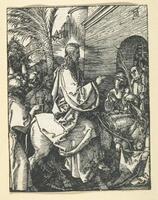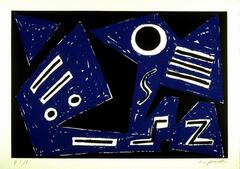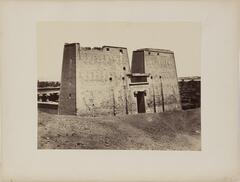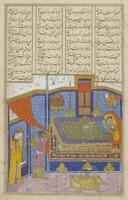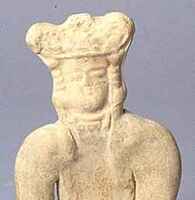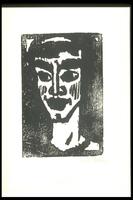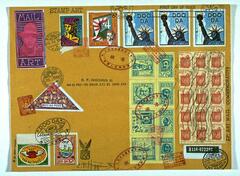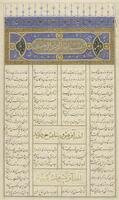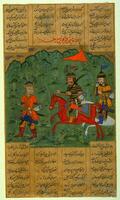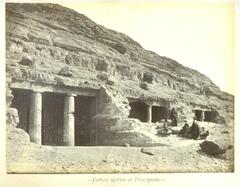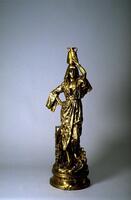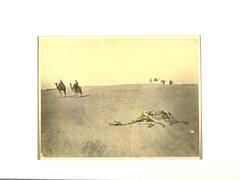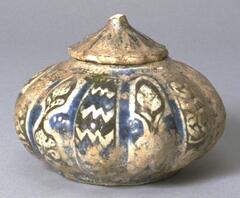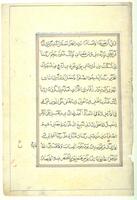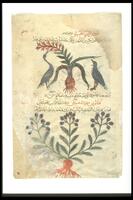22 Items in this Learning Collection
Collection Object
Collection Object
Collection Object
Collection Object
Collection Object
Collection Object
Collection Object
Collection Object
Collection Object
Collection Object
Collection Object
Collection Object
Collection Object
Collection Object
Collection Object
Collection Object
Collection Object
Collection Object
Collection Object
Copyright
All Rights Reserved
()
Cover of Ann Arbor Shahnameh (First heading)
Accession Number
1963/1.39C
Title
Cover of Ann Arbor Shahnameh (First heading)
Artist(s)
Iranian
Artist Nationality
Iranian
Object Creation Date
circa 1460
Medium & Support
ink, opaque watercolor, and gold leaf on paper
Dimensions
10 1/2 in. x 6 15/16 in. ( 26.7 cm x 17.7 cm )
Credit Line
Museum Purchase
Label copy
From the thirteenth century through early modern times, books were the most important material emblem of culture in the advanced civilizations of central Asia. Powerful emperors and warlords built great libraries of works on science (such as astronomy and astrology, herbal lore, and medical texts) as well as poetry, dynastic histories, and copies of the holy Qur’an. As paper was still a rare item and printing had not yet been invented, books were luxury items of the highest order, requiring expensive materials and skilled labor at each step in their making.
This manuscript of the Shahnama, like all other books for the royal libraries of the Timurids, Mughals, and Persians, was copied out entirely by hand. It required great skill and discipline for the calligrapher to sustain the same quality, style, and scale of handwriting page after page.
When the Museum acquired the manuscript in 1963, a decision was made to remove the illustrated pages, so that they could be displayed in protective frames, as in this exhibition. The manuscript is shown open to the pages that originally flanked “Zal Goes to Rudaba,” the third miniature painting in the exhibition. Traces of mineral pigments rubbed off on the page at right.
The language of the Shahnama is Persian, but the script used is a modified form of Arabic, which is written from right to left. The use of gold on several pages and lapis lazuli blue in the design for chapter headings testifies to the wealth of the patron and the importance he placed on this project.
———
Maribeth Graybill, Senior Curator of Asian Art
Exhibited in "A Medieval Masterpiece from Baghdad: the Ann Arbor Shahnama"
August 14 through December 19, 2004
Subject matter
See physical description.
Physical Description
This leaf is from a manuscript of the epic poem, Shahnama of Firdausi and features columns of Persian-Farsi calligraphy with an illuminated chapter heading at the top of the page.
Primary Object Classification
Painting
Primary Object Type
narrative painting
Collection Area
Western
Rights
If you are interested in using an image for a publication, please visit http://umma.umich.edu/request-image for more information and to fill out the online Image Rights and Reproductions Request Form.
Keywords
Persian-Farsi (language)
Shahnama
gold leaf
gouache (paint)
illuminated manuscripts
shahs
watercolor painting (technique)
1963/1.39C
Title
Cover of Ann Arbor Shahnameh (First heading)
Artist(s)
Iranian
Artist Nationality
Iranian
Object Creation Date
circa 1460
Medium & Support
ink, opaque watercolor, and gold leaf on paper
Dimensions
10 1/2 in. x 6 15/16 in. ( 26.7 cm x 17.7 cm )
Credit Line
Museum Purchase
Label copy
From the thirteenth century through early modern times, books were the most important material emblem of culture in the advanced civilizations of central Asia. Powerful emperors and warlords built great libraries of works on science (such as astronomy and astrology, herbal lore, and medical texts) as well as poetry, dynastic histories, and copies of the holy Qur’an. As paper was still a rare item and printing had not yet been invented, books were luxury items of the highest order, requiring expensive materials and skilled labor at each step in their making.
This manuscript of the Shahnama, like all other books for the royal libraries of the Timurids, Mughals, and Persians, was copied out entirely by hand. It required great skill and discipline for the calligrapher to sustain the same quality, style, and scale of handwriting page after page.
When the Museum acquired the manuscript in 1963, a decision was made to remove the illustrated pages, so that they could be displayed in protective frames, as in this exhibition. The manuscript is shown open to the pages that originally flanked “Zal Goes to Rudaba,” the third miniature painting in the exhibition. Traces of mineral pigments rubbed off on the page at right.
The language of the Shahnama is Persian, but the script used is a modified form of Arabic, which is written from right to left. The use of gold on several pages and lapis lazuli blue in the design for chapter headings testifies to the wealth of the patron and the importance he placed on this project.
———
Maribeth Graybill, Senior Curator of Asian Art
Exhibited in "A Medieval Masterpiece from Baghdad: the Ann Arbor Shahnama"
August 14 through December 19, 2004
Subject matter
See physical description.
Physical Description
This leaf is from a manuscript of the epic poem, Shahnama of Firdausi and features columns of Persian-Farsi calligraphy with an illuminated chapter heading at the top of the page.
Primary Object Classification
Painting
Primary Object Type
narrative painting
Collection Area
Western
Rights
If you are interested in using an image for a publication, please visit http://umma.umich.edu/request-image for more information and to fill out the online Image Rights and Reproductions Request Form.
Keywords
Persian-Farsi (language)
Shahnama
gold leaf
gouache (paint)
illuminated manuscripts
shahs
watercolor painting (technique)
